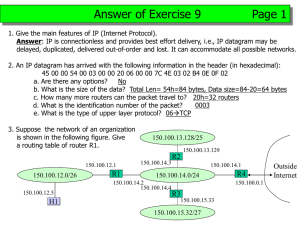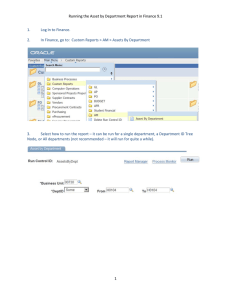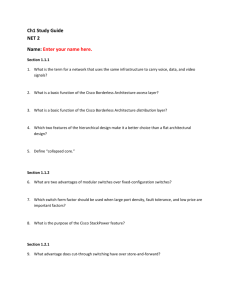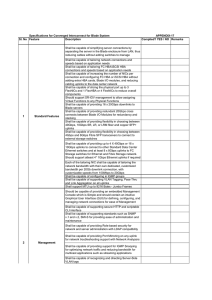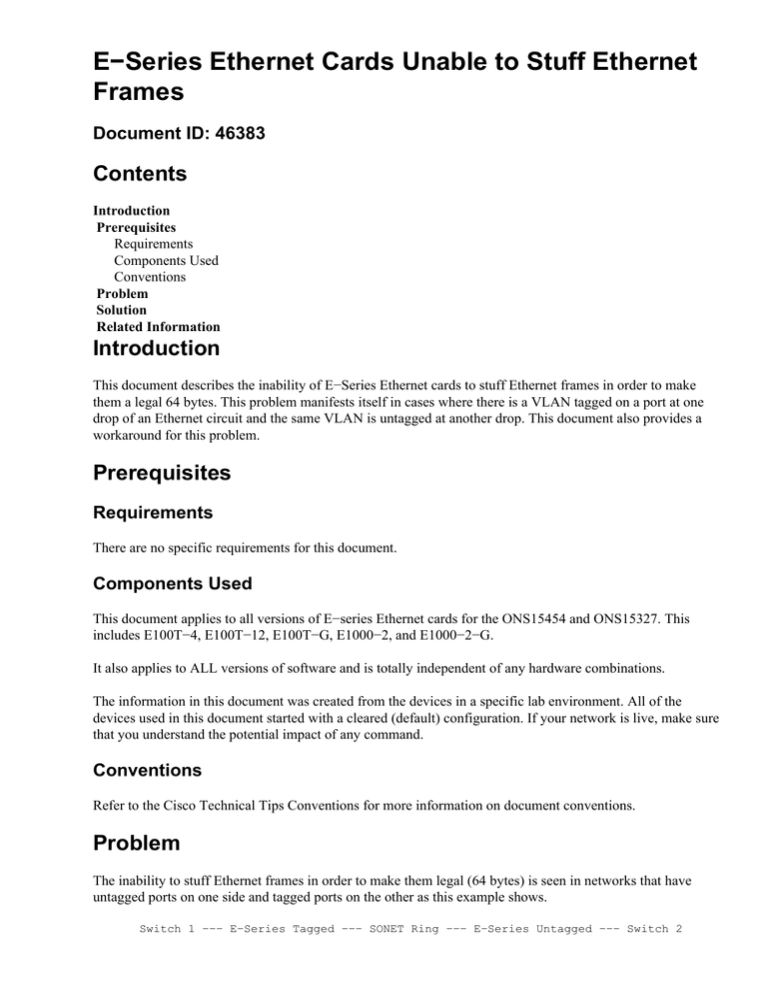
E−Series Ethernet Cards Unable to Stuff Ethernet
Frames
Document ID: 46383
Contents
Introduction
Prerequisites
Requirements
Components Used
Conventions
Problem
Solution
Related Information
Introduction
This document describes the inability of E−Series Ethernet cards to stuff Ethernet frames in order to make
them a legal 64 bytes. This problem manifests itself in cases where there is a VLAN tagged on a port at one
drop of an Ethernet circuit and the same VLAN is untagged at another drop. This document also provides a
workaround for this problem.
Prerequisites
Requirements
There are no specific requirements for this document.
Components Used
This document applies to all versions of E−series Ethernet cards for the ONS15454 and ONS15327. This
includes E100T−4, E100T−12, E100T−G, E1000−2, and E1000−2−G.
It also applies to ALL versions of software and is totally independent of any hardware combinations.
The information in this document was created from the devices in a specific lab environment. All of the
devices used in this document started with a cleared (default) configuration. If your network is live, make sure
that you understand the potential impact of any command.
Conventions
Refer to the Cisco Technical Tips Conventions for more information on document conventions.
Problem
The inability to stuff Ethernet frames in order to make them legal (64 bytes) is seen in networks that have
untagged ports on one side and tagged ports on the other as this example shows.
Switch 1 −−− E−Series Tagged −−− SONET Ring −−− E−Series Untagged −−− Switch 2
Switch 1 sends a 64−byte Address Resolution Protocol (ARP) for the MAC address of switch 2. The 64 byte
frame consists of 60 bytes plus 4 bytes of VLAN tag information. When this ARP arrives at the untagged
Ethernet port, the VLAN tag is removed since the port is untagged. This reduces the frame size to 60 bytes,
which is illegal for Ethernet. Switch 2 drops the frame and increments the "runt" counter. Most switches are
able to detect that the frame is illegal once the VLAN tag is removed and "stuff" the frame with an additional
4 bytes of zeroes in order to make the frame a valid size of 64 bytes.
Solution
Complete these steps in order to resolve this issue:
1. Configure both ends for "tagged" ports.
2. If you are unable to set both ends for tagged ports due to a switch that is not able to understand VLAN
tags, you can configure static ARP entries in each switch. This allows the switch to know about the
MAC address of the far end switch without a need to perform an ARP.
Related Information
• Technical Support & Documentation − Cisco Systems
Contacts & Feedback | Help | Site Map
© 2013 − 2014 Cisco Systems, Inc. All rights reserved. Terms & Conditions | Privacy Statement | Cookie Policy | Trademarks of
Cisco Systems, Inc.
Updated: May 16, 2006
Document ID: 46383




